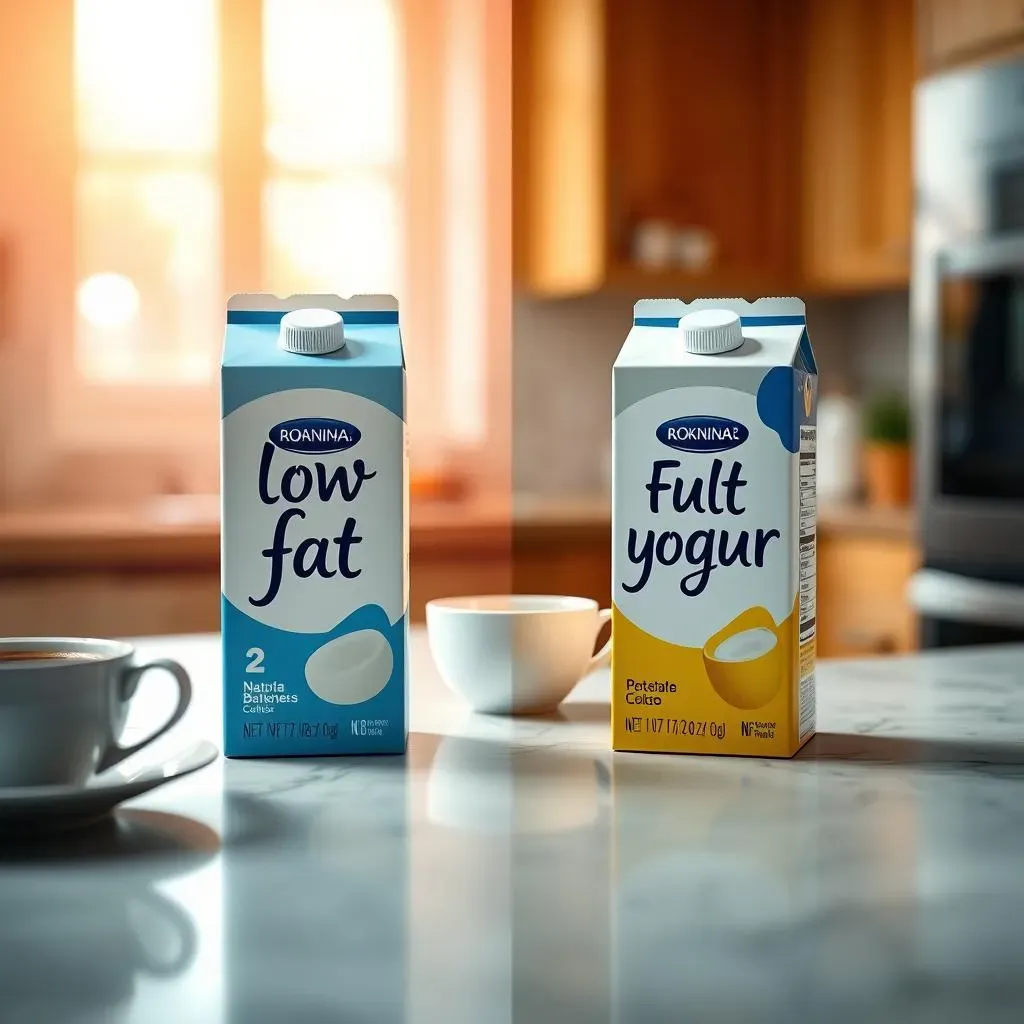Table of Contents
In the swirling vortex of the health food aisle, navigating the yogurt section can feel like decoding ancient runes. Are you Team Low Fat, lured by the promise of fewer calories? Or are you a Full Fat fanatic, convinced that the real deal is the only way to go? The debate between low fat yogurt or full fat options has been raging for years, leaving consumers scratching their heads and wondering if they're making the right choice. This article cuts through the confusion, serving up the facts you need to decide which yogurt truly reigns supreme. We'll delve into the hidden sugars lurking in some low fat varieties, explore the satisfying power of full fat, and guide you toward making informed decisions that align with your health goals. Get ready to ditch the diet dogma and discover the delicious truth about yogurt.
Low Fat vs. Full Fat: Understanding the Yogurt Debate

Low Fat vs. Full Fat: Understanding the Yogurt Debate
let's dive into this yogurt conundrum. For years, we've been bombarded with the message that "fat is bad," leading many to automatically reach for the low fat yogurt options. But hold up! It's not quite that simple. The core of the debate boils down to this: what happens when you remove the fat? Does it magically make the yogurt healthier, or are there sneaky trade-offs we need to consider? It's like that old saying, "The devil is in the details," and in this case, the details are hiding in the ingredient list.
Think of it like this: food manufacturers still want that yogurt to taste good, right? So, when they yank out the fat – which contributes to that creamy, satisfying texture – they often compensate with other ingredients. And guess what those ingredients often are? Sugar, artificial sweeteners, and thickeners. Suddenly, that "healthy" low fat yogurt might be packing a bigger sugar punch than you bargained for. It is kind of like swapping out your regular soda for a diet one, only to find it's loaded with artificial sweeteners that leave a weird aftertaste.
Full fat yogurt, on the other hand, gets to keep its natural fat content. This means it often has a richer, more satisfying flavor and texture without needing all those added extras. Plus, the fat itself can help you feel fuller for longer, which can be a win-win if you're watching your weight. So, before you blindly grab that low fat container, let's dig deeper into what's really going on beneath the surface.
The Downside of Low Fat Yogurt: What Are You Really Eating?

The Downside of Low Fat Yogurt: What Are You Really Eating?
The Sugar Trap
so you've grabbed that low fat yogurt, thinking you're making a stellar choice. But have you flipped that container around and peeked at the nutrition label? Brace yourself. All that fat had to be replaced with something. Often, that "something" is sugar. And not the naturally occurring kind from the milk, but added sugars like sucrose, fructose, or high-fructose corn syrup. These sugars are added to compensate for the loss of flavor and texture that fat provides. It's kind of like a sneaky substitution – you're cutting fat, but unknowingly loading up on sugar, which can wreak havoc on your blood sugar levels and contribute to weight gain. It's like thinking you're being healthy by ordering a salad, only to drown it in a sugary dressing.
Why is this a problem? Added sugars provide empty calories, meaning they offer little to no nutritional value. Consuming too much added sugar has been linked to a whole host of health issues, including weight gain, type 2 diabetes, heart disease, and even certain types of cancer. So, while you might think you're doing your body a favor by choosing low fat, you could actually be doing more harm than good if you're inadvertently increasing your sugar intake. It's a classic case of smoke and mirrors in the food industry.
Artificial Sweeteners and Other Additives
But the sugar overload isn't the only potential pitfall. To further enhance the flavor and texture of low fat yogurts, manufacturers often turn to artificial sweeteners and other additives. These can include things like aspartame, sucralose, and acesulfame potassium, as well as artificial flavors, colors, and thickeners. While these additives might make the yogurt taste better and have a more appealing texture, they also come with their own set of potential drawbacks. It's like adding a bunch of artificial ingredients to a cake mix to make it taste better, but sacrificing the quality of the ingredients.
Some people are sensitive to artificial sweeteners and may experience side effects like headaches, digestive issues, or even changes in their gut microbiome. Artificial colors and flavors have also been linked to hyperactivity in children. And let's not forget the thickeners, like modified food starch or carrageenan, which are often added to give low fat yogurt a creamier consistency. Some studies have suggested that carrageenan may contribute to inflammation in the gut. So, before you reach for that artificially sweetened, brightly colored low fat yogurt, consider whether the potential risks outweigh the perceived benefits.
Additive | Potential Concerns |
|---|---|
Aspartame | Headaches, digestive issues (in sensitive individuals) |
Sucralose | May alter gut microbiome |
Artificial Colors | Hyperactivity in children |
Carrageenan | Potential gut inflammation |
Full Fat Yogurt Benefits: Satiety, Taste, and More

Full Fat Yogurt Benefits: Satiety, Taste, and More
Alright, let's flip the script and talk about the good stuff – the reasons why full fat yogurt might actually be your new best friend. Forget everything you've heard about fat being the enemy, because when it comes to yogurt, fat can be a total game-changer. The biggest advantage? Satiety. That creamy, rich texture isn't just delicious; it's also incredibly satisfying. The fat content helps slow down digestion, which means you'll feel fuller for longer after eating full fat yogurt compared to its low fat counterpart. That's a huge win if you're trying to manage your weight or simply avoid those mid-afternoon snack cravings. It's like the difference between a quick sugar rush and a slow-burning energy source – one leaves you crashing, while the other keeps you going strong.
And let's not forget about the taste! Full fat yogurt simply tastes better. It has a richer, more complex flavor that's naturally delicious without needing all those added sugars and artificial ingredients. It's like comparing a real vanilla bean to vanilla extract – one is subtle and nuanced, while the other can be overly sweet and artificial. Plus, the fat in yogurt helps you absorb fat-soluble vitamins like A, D, E, and K, which are essential for overall health. So, you're not just enjoying a delicious snack; you're also boosting your nutrient intake. It's a win-win situation!
Navigating the Yogurt Aisle: How to Choose the Best Option for You

Navigating the Yogurt Aisle: How to Choose the Best Option for You
so you're standing in front of that massive yogurt display, feeling totally overwhelmed. Don't worry, I've been there! The key is to become a label-reading ninja. First, ignore the marketing hype plastered all over the container. Focus on the nutrition facts and ingredient list. Look for yogurts with the fewest added sugars – ideally, less than 10 grams per serving. Remember, some sugar is natural from the milk (lactose), but anything above that is added. The ingredient list should be short and sweet, with recognizable ingredients. Avoid yogurts loaded with artificial sweeteners, flavors, colors, and thickeners. It's like trying to decipher a secret code, but once you know what to look for, it gets easier!
Next, consider your personal preferences and dietary needs. Are you trying to boost your protein intake? Greek yogurt is your go-to. Are you looking for a creamy, decadent treat? Full fat yogurt might be the answer. Do you have any dietary restrictions, like lactose intolerance? There are plenty of lactose-free yogurt options available. It's all about finding the right fit for you. And don't be afraid to experiment! Try different brands and flavors until you find something you truly enjoy. Yogurt should be a delicious and satisfying part of your diet, not a chore.
Finally, remember that portion control is key. Even the healthiest yogurt can contribute to weight gain if you're eating too much of it. Stick to a single serving size and pair it with other healthy foods, like fruit, nuts, or seeds, for a balanced and satisfying snack or meal. It's all about mindful eating and making informed choices that support your overall health and well-being. So, go forth and conquer that yogurt aisle! You've got this!
Factor | Considerations |
|---|---|
Added Sugar | Aim for less than 10 grams per serving |
Ingredients | Short and recognizable list; avoid artificial additives |
Protein Content | Greek yogurt is a good source |
Dietary Needs | Lactose-free options available |
Portion Size | Stick to a single serving |
Beyond Low Fat Yogurt or Full Fat: Exploring Other Healthy Yogurt Choices

Beyond Low Fat Yogurt or Full Fat: Exploring Other Healthy Yogurt Choices
Diving into Dairy-Free Delights
so we've dissected the low fat yogurt or full fat debate, but what if you're looking for something completely different? Maybe you're lactose intolerant, vegan, or just curious about the alternatives. Fear not, my friend, because the world of yogurt is expanding beyond traditional dairy! We're talking about plant-based yogurts made from everything from almonds and cashews to coconuts and oats. These options are not only delicious but also packed with their own unique nutritional benefits. It's like discovering a whole new continent of flavor possibilities!
Almond yogurt, for example, is often lower in calories and sugar than traditional yogurt, while coconut yogurt is rich in healthy fats and has a creamy, decadent texture. Oat yogurt is a great source of fiber, which can help keep you feeling full and satisfied. And cashew yogurt? Well, let's just say it's incredibly smooth and luxurious. The best part is that many of these dairy-free yogurts are fortified with vitamins and minerals, like calcium and vitamin D, to ensure you're getting the nutrients you need. It's like having your cake (or yogurt) and eating it too!
Exploring Global Yogurt Traditions
But wait, there's more! The world of yogurt extends far beyond the familiar grocery store brands. In fact, many cultures have their own unique yogurt traditions that are worth exploring. Take skyr, for example, an Icelandic yogurt that's incredibly thick, creamy, and high in protein. Or labneh, a Middle Eastern yogurt cheese that's tangy and versatile. And let's not forget about kefir, a fermented milk drink that's packed with probiotics and gut-friendly bacteria. It's like embarking on a culinary adventure around the world, one spoonful at a time!
These traditional yogurts often have a richer history and a more authentic flavor than mass-produced varieties. Plus, they can offer unique health benefits. Kefir, for instance, is known for its ability to improve digestion and boost the immune system. So, next time you're feeling adventurous, consider branching out and trying a new type of yogurt. You might just discover your new favorite breakfast or snack. It's like finding a hidden gem in a sea of ordinary stones!
Yogurt Type | Origin | Characteristics | Potential Benefits |
|---|---|---|---|
Skyr | Iceland | Thick, creamy, high in protein | Satiety, muscle building |
Labneh | Middle East | Tangy, versatile, yogurt cheese | Probiotics, healthy fats |
Kefir | Eastern Europe | Fermented milk drink | Improved digestion, immune boost |
The Verdict: Finding Your Perfect Yogurt Balance
Ultimately, the choice between low fat yogurt or full fat yogurt isn't about rigid rules, but about finding a sustainable balance that works for you. Don't be swayed by fleeting diet trends; instead, focus on reading labels, understanding your body's needs, and choosing options that are both nutritious and enjoyable. Whether you're reaching for a creamy full fat Greek yogurt or a lighter low fat option, remember that yogurt can be a delicious and versatile part of a healthy diet. So, experiment, explore, and discover your own personal yogurt sweet spot!
